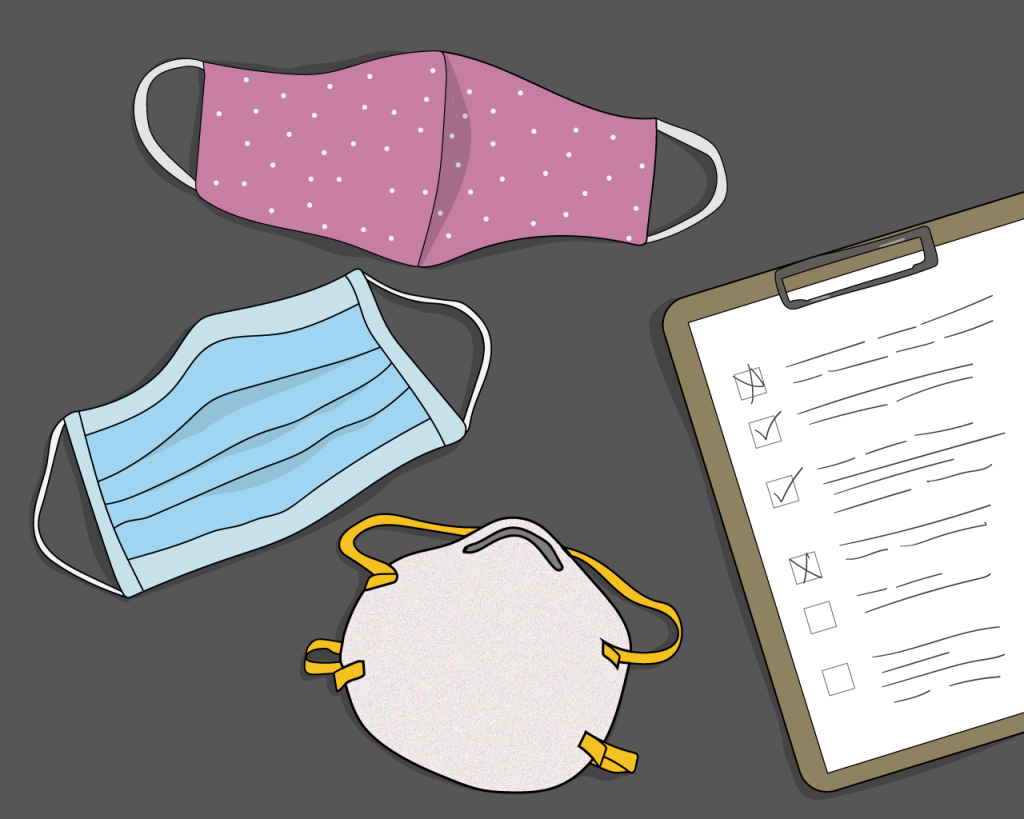With COVID-19 positivity rates still on the rise, researchers are searching for the most effective mask technique to reduce the spread.
Scott Schiffres, an assistant professor of mechanical engineering, and his team of researchers conducted a study to test the effectiveness of various mask materials against COVID-19. Their research paper, titled “Filtration Efficiency, Breathability and Reusability of Improvised Materials for Face Masks,” was recently accepted into Aerosol Science and Technology, a peer-reviewed academic journal.
The team of engineering graduate students built a system through which they could test the filtration efficiency, reusability and breathability of varying mask materials in order to find which materials best prevent the spread of the virus. Filtration efficiency is the ability of the mask material to block out COVID-19 particles, while breathability relates to the comfort level of the mask, such as the ability to breathe through it. They specifically tested the filtration efficiency of cotton and sterilization wraps to see their effectiveness in blocking out COVID-19 particles.
“We found that cotton is decent but highly variable,” Schiffres wrote in an email. “One material that works well and is reusable is sterilization wraps, which are used to sterilize and package medical devices and instruments.”
Morteza Bagheri, ‘20, and an assistant researcher in Schiffres’ experiment, explained that different types of masks are more or less beneficial depending on the situation.
“If you’re a first responder or dealing with people who might have [COVID-19], you’ll need a type three surgical mask or N95,” Morteza said. “I would recommend, for anyone who is interested, to look at the filtration efficiency of your mask material [on the CDC website].”
In regard to double-masking, the team tested cotton-on-cotton and cotton layered with surgical wraps. Surgical wraps are fabric typically used for injured patients, widely available in hospitals. The researchers believed that this material might be more effective in blocking out COVID-19. It was also found that doubling up cotton masks is more effective for particle filtration than using one alone. However, double-masking may impact the fit, which may compromise breathability.
“We tested the efficiency of the filtration, not the efficiency of the fit,” Bagheri said. “Cotton material is normally woven [and is] not usually effective in terms of filtration because of the thread count. Adding multiple layers will normally enhance the filtration at the cost of breathability.”
Schiffres noted his motivations for conducting the experiment, explaining that he temporarily changed his focus of research from heat transfer and additive manufacturing to mask-wearing when the COVID-19 pandemic began in order to study current issues in the scientific community. The team of mask researchers, Bagheri included, is a new team of engineers composed specifically for the COVID-19 mask research.
“It really started out of curiosity back last late February/early March, when there was no recommendation to wear masks and I was curious about how improvised masks performed,” Schiffres wrote. “My research is normally on nanoscale heat transfer and additive manufacturing, but when [COVID-19] started, I realized I could repurpose some of the cleanroom and vacuum equipment we had access to measure filtration efficiency.”
Due to the pandemic, the team had limited access to their lab space and was forced to adjust to the circumstances. This left significant portions of their research to be conducted in alternate locations, including homes and garages. Bagheri also noted the issue of time-sensitivity as COVID-19 was spreading, and the team wanted to develop and share their research as quickly as possible.
“[A] big challenge for us [was trying] to get the results in a very short-time,” Bagheri said. “We had to look at what equipment we had in the lab and tried to see how we could repurpose those. As a matter of timing, it was very hectic. We might have missed some key aspects of testing, but later we came back and looked at those again.”
Bagheri noted the advantages of earning scientific credibility in the world of research.
“Now that it’s peer reviewed and published in a journal, it has more credibility,” Bagheri said. “This means that more reviewers will look at this work and point out the flaws.”



